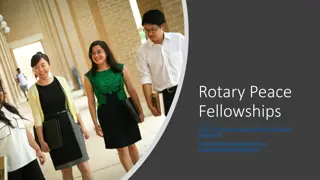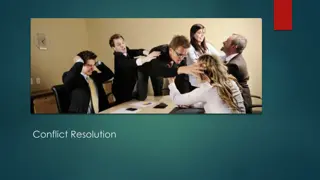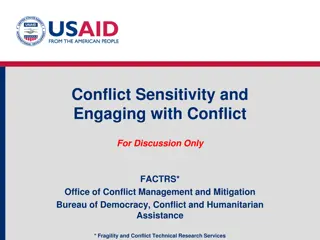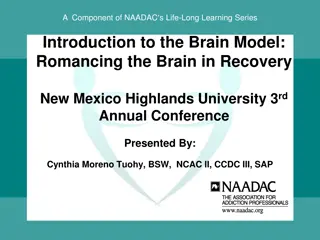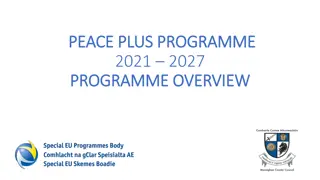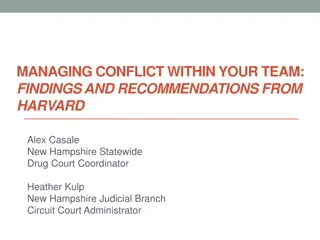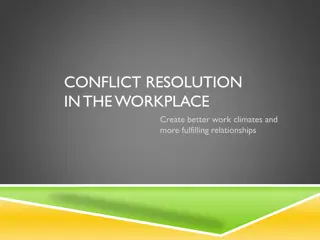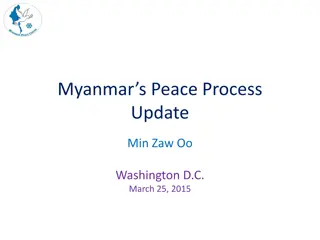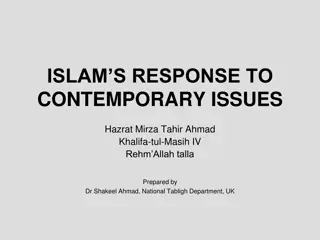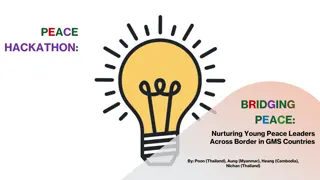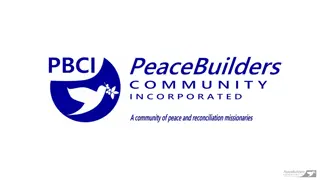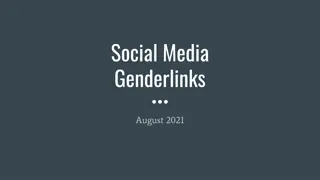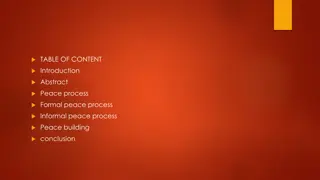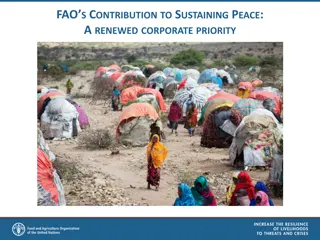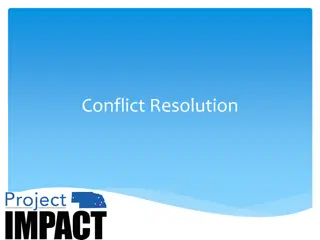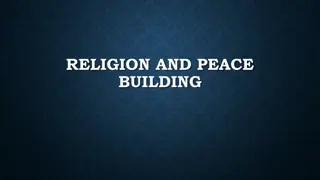Leveraging Mass Media for Conflict Resolution & Peace Building in Africa
The critical role of mass media in conflict resolution is often overlooked, though it can also escalate violence. This presentation highlights how the media can reverse negative roles to enhance peace building in Africa, focusing on types of conflicts, phases of conflict, and the evolving role of media in conflict resolution through new technologies like social media and citizen journalism.
Download Presentation

Please find below an Image/Link to download the presentation.
The content on the website is provided AS IS for your information and personal use only. It may not be sold, licensed, or shared on other websites without obtaining consent from the author. Download presentation by click this link. If you encounter any issues during the download, it is possible that the publisher has removed the file from their server.
E N D
Presentation Transcript
USING THE MASS MEDIA FOR CONFLICT RESOLUTION & PEACE BUILDING The critical role of the media in conflict resolution has for the most part been ignored, while its potential tendency to escalate violent phases of a conflict are most highlighted. The mass media through its surveillance function has indeed escalated some crisis notably the Rwanda and Serbian Crisis, ( Temple-Raston, 2005), the Danish Cartoon Controversy, (Bonde, 2007) etc. This presentation aims to discuss ways through which this negative roles can be reversed so that the mass media systems in Africa can perform greater peace building roles rather than escalation of conflict.
Types of Conflicts High Intensity Conflict where violence is primarily interstate, Low Intensity Conflict where violence is much more limited and is pursued by irregular forces against regular armies, within the state. Luttwak, (2001) uses the term post heroic war to describe the essence of LIC. Because the nature of LICs is complex, involving historical, cultural, religious ideologies, principles, etc, they are localized but pose serious international security implications, and are more difficult to resolve. Eg. Rwanda, Kenya, Sudan, Somalia, Congo, Liberia, etc. Media coverage of LICs is crucial but problematic because they are often locally involved.
Phases of Conflict It is essential to identify phases of conflict so that the mass media role at every stage can be planned effectively. The phases include 1. onset prevention,2. escalation management,3.De-escalation resolution, 4. Termination- Reconciliation. At each of these stages, the role of the mass media is distinct. At the first stage, the media function is to provide prevention information that can stop the conflict from deteriorating into violence. If this succeeds, conflict terminates temporarily or permanently.
Phases of Conflict If prevention fails, violence ensures. At this point, media scholars are divided as to what should be the mainstream media approach. ( more on this later) generally however, the level at which the media operates decides the approach, local, national or international media may report the conflict differently. The post conflict period also involves resolution and reconciliation. Until the various parties internalize the spirit and letter of the resolution, reconciliation will not happen. The media role here is ensure complete coverage of the resolution thereby ensuring reconciliation takes place.
Role of the media in Conflict Resolution The advent of new media technologies, including the internet, smartphones, social media, etc., has transformed the nature of information sharing and the role of the audiences, power of the state actors and led to a more empowered citizenry. The concept of citizen journalism through blogs, twitter handles, etc. is gaining greater mileage. Its no longer easy to withhold or hide information from the citizens, even as social media information has become less reliable. Live reporting is no longer an exclusive domain of global news agencies and the media is ever more interactive and pro weak and the poor.
Peace building through Journalism Peace building through Journalism The debate on media coverage of conflict continues to rage with key actors adopting various positions. There is the concept of Bystander Journalism Vs Journalism of Attachment . Bell (1997) criticizes neutrality and objectivity in conflict reporting claiming that bystander journalists are only interested in the circumstances of war, while the journalists of attachment are concerned with the people, those who provoke wars, those who fight them and those who suffer the consequences of war. He concludes that journalists of attachment do not stand neutral between the forces of evil and good. They take a position. CNN s Christiane Amanpour, Ed Vulliamy support this view. During the Balkan War, they openly supported the Muslims and advocated for military operations against the Serbs. ( See Maclaughlin, 2002, for more on this debate)
The Critique of Neutrality Gowing, (1997), Hume, (1997) Ward, (1998) and many others argued that journalism of attachment threatens professional journalism and can bring in bias, prejudice and moral dilemma. Ward, (1998) thought that Bell s neutrality argument is too narrow and dangerous and makes journalists judge and jury at the same time. Galtung and Kemp ( 2002) offered an alternative to war journalism which is peace journalism. Which focuses on conflict transformation and peace building. In contradistinction to war journalism, which celebrates heroism, victory and ignores the human casualties of war, peace journalism focuses more on providing voice to all parties, shows empathy and understanding. It s a humanizing approach to war coverage.
Critique of Peace Journalism Thomas (2004) criticizes the concept of peace journalism claiming that is based on a false assumption of a powerful, causal, and linear media effect. But communication theory has identified multiple audiences with different characteristics. Peace Journalism assumes that the audience is an aggregate of dispersed audiences, but communication theory suggests that this assumption is unnatural and economically impossible. Whilst peace journalism assumes that the mass media should be responsible for peace, the sociological system places this responsibility on political institutions and leaders.
Conflict, Journalism and the future of Africa Denis McQuail ( 1987) has since espoused another normative theory of the press in which he specifically places a developmental role for the media. He sums up the role of the media in his development media theory, thus: The mass media should accept and carry out positive developmental tasks in line with national policies. Its freedom should be subject to economic priorities. Media has responsibilities along with freedom and should respect culture, African spirit of neighborliness, and promote nationalism.
Conclusion In order to harness usefulness of mass media as tools for conflict resolutions, the following are essential Clear Vision and Mission: A leadership that clearly sees and appreciates the developmental potential of the mass media and its capacity to catapult the process of social change. A sound policy that creates the enabling environment for mass media to deliver its critical functions. ( Media for development not only Entertainment) A general reform process that restructures the media organizations, builds capacity, increase funding and provide regular supervision and content development guidelines.
Conclusion Enhance professional journalistic practices, operational standards/ guidelines and protection against hazard. Promote media pluralism and give voice to the communities through community media that s cheap and affordable as well as community oriented towards grassroots issues. Legal reforms that protect the journalists in their conflict reporting and also strengthens other laws that protect the people and ensure national security. Makes new laws for the social media that regulate the practice of citizen journalism but does not censor information.
Discussion How, in your own opinion, can the media contribute towards peace building and conflict resolution?
Thank You Mrs.Binta Suleiman Gaya Dept. of Mass Communication Faculty of Communication BUK. GSP 2206 2016



